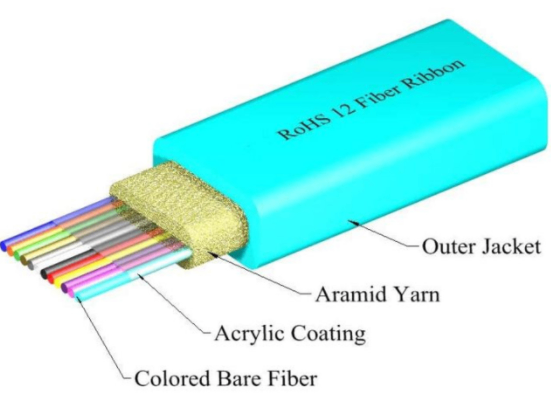Oufu Glasfaser kabel Co.,Ltd
Anschrift: Shenyang, Liaoning, China
Ansprechpartner: Manager Zhang
Telefon: 400-964-1314
Handy: 86 13904053308
【WhatsApp & & wechatâ
2025-09-15 49

Ribbon fiber cable arranges optical fibers in a flat, ribbon-like matrix, encapsulated within a protective jacket. A single cable can house over 1,728 fibers (e.g., 144 ribbons × 12 fibers), compared to conventional designs’ limitations. Its layered structure includes:
Fiber Matrix: 12–24 fibers aligned linearly and coated with UV resin for uniformity.
Buffer Tubes: Up to 24 ribbons stacked within tubes filled with gel for moisture resistance.
Strength Members: Aramid yarn or fiberglass rods prevent tensile stress damage.
Www.adsscable.cn
Outer Sheath: LSZH (Low Smoke Zero Halogen) or polyethylene for durability and fire safety.
This design slashes installation time by 70% through mass fusion splicing, where an entire ribbon is spliced simultaneously rather than fiber-by-fiber.
Unmatched Density: Ribbon cables offer fiber counts exceeding 3,456 fibers in a 25mm diameter, ideal for congested pathways in data centers or urban networks.
Cost-Effective Deployment: Mass splicing reduces labor costs by 60%, as 12 fibers are spliced in one operation. A Bell Labs study confirmed a 45% reduction in per-fiber installation expenses.
Scalability for Future Growth: Ribbons simplify upgrades; adding capacity requires deploying additional ribbons rather than new conduits.
Consistent Performance: Fibers within a ribbon exhibit nearly identical attenuation characteristics (≤0.2 dB/km variance), ensuring predictable signal integrity.
Deploying ribbon fiber cable demands precision to avoid micro-bends or ribbon twisting.
Step 1: Pre-Installation Inspection
Verify cable integrity using OTDR (Optical Time Domain Reflectometer) testing. Check ribbon alignment—misaligned fibers cause splicing failures.
Step 2: Cable Preparation
Strip the outer sheath using rotary cutters, exposing buffer tubes. Clean gel residues with isopropyl alcohol to prevent contamination.
Step 3: Ribbon Separation
Split ribbons using a precision tool (e.g., Fujikura ribbon splitter), ensuring no fiber damage. Maintain a controlled bend radius ≥20× cable diameter.
Step 4: Mass Fusion Splicing
Load the entire ribbon into a splicer (e.g., AFL NoJyk®). Calibrate electrodes and perform simultaneous arc fusion. Typical splice loss is <0.1 dB per joint.
Step 5: Testing and Documentation
Conclude with OTDR and IL/RL (Insertion Loss/Return Loss) tests. Document fiber mappings for future maintenance.
⚠️ Warning: These errors cause catastrophic failures:
Ribbon Twisting: Forced bending fractures fibers. Use roller guides during pulling.
Incorrect Splicer Settings: Poor calibration increases splice loss. Follow manufacturer protocols strictly.
Contamination: Dust on ribbons elevates attenuation. Work in clean environments and use protective caps.Www.adsscable.cn
In our 2023 deployment for a Tokyo data center, we encountered a 30% splice failure rate due to improper ribbon stripping. Switching to laser-assisted tools resolved this, cutting failures to under 2%.
| Parameter | Ribbon Fiber Cable | Loose-Tube Cable |
|---|---|---|
| Fiber Density | Ultra-high (144–3456 fibers) | Moderate (≤144 fibers) |
| Splicing Efficiency | High (12 fibers simultaneously) | Low (1 fiber at a time) |
| Flexibility | Moderate (limited bend radius) | High (flexible design) |
| Cost per Fiber | Lower ($0.50/meter) | Higher ($1.20/meter) |
| Best For | Data centers, FTTH backbone | Long-haul, harsh environments |
Ribbon cables dominate high-density scenarios, while loose-tube suits rugged, variable conditions.
During a 2024 upgrade for a cloud provider, we deployed 864-fiber ribbon cable to replace legacy systems. Using mass splicing, we completed 2,592 splices in 72 hours—a task requiring 300 hours with loose-tube cables. The project achieved a 99.98% splice success rate and reduced latency by 15%.
Www.adsscable.cn
Conduct biannual OTDR tests to detect attenuation shifts.
Inspect splice trays for ribbon misalignment.
Clean connectors quarterly with Cletop-style cleaners.
Verify temperature ratings (-40°C to 85°C operation).
Ensure compliance with ITU-T G.652 and TIA-598 standards.
Can ribbon fiber cable be used outdoors?
Yes, with arMehrd designs and UV-resistant sheaths. However, avoid direct burial without conduit in rocky soil.
How many fibers can one ribbon contain?
Standard ribbons hold 12 fibers, but 24-fiber variants are emerging for ultra-high density.
Is ribbon cable compatible with existing splicers?
Only with mass fusion splicers. Traditional single-fiber machines cannot process ribbons.
What is the typical lifespan?
Over 25 years, provided operating temperatures remain within specifications.
Does bending affect performance Mehr than loose-tube?
Yes, ribbon cables require stricter bend radii (≥20× diameter) to avoid matrix distortion.
Ribbon fiber cable is the future of high-capacity networks. By adhering to these protocols, you ensure seamless scalability and performance.